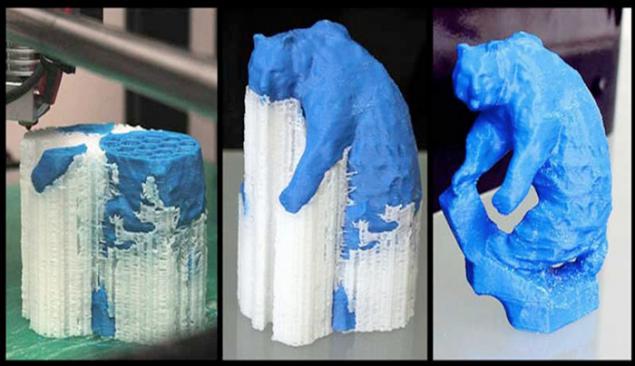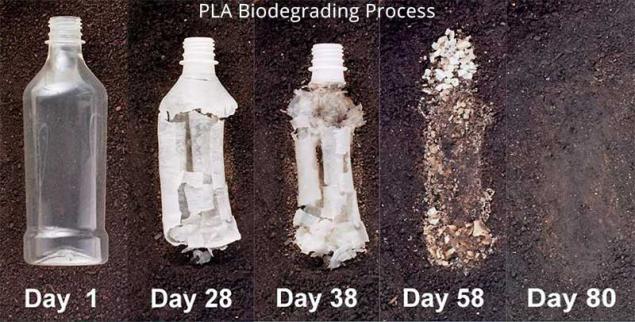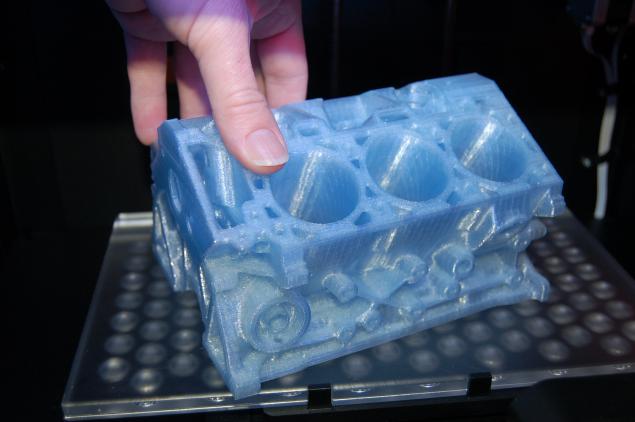How to produce PLA for 3d-printer. Report from the workshop
 Bashny.Net
Bashny.Net
Pistol shot was the signal to create a business.
In order to dispel the myths that plastic spool for 3d-printers grow on trees, you can only buy and resell, as well as that is enough to buy "all-in-one" extruder and start your own business, I went on to explore Moscow manufacturers ABS and PLA (and HIPS). Indeed, I found myself in a professional shop with industrial equipment, with measuring and controlling devices of high precision, high standards for cleanliness (for the production process very responsible) and sociable founders (ready to share knowledge with curious and I think the audience), in which a bunch of ideas and tehnokreativnyh plans to take over the world market. (5 to the level of national pride)
As I told a co-founder of the company: «First we saw the printed knife for fruit, and purified them from the peel of an orange, then shock was video with a gun Cody Wilson and away we go ...» i>
At the time when I wrote Habré first 2 articles about 3d-printers (Spring 2013), these guys have already started to build a business for the production of plastic. It is interesting that for me and they came up with a similar idea, as can be supplemented by saying, well, a man can endlessly watch the fire, the water, how the other person is and how print 3d-printer.
Polylactide (PLA, PLA) - biodegradable, biocompatible, thermoplastic aliphatic polyester, which monomer is lactic acid. The raw material for the production are annually renewable resources such as corn and sugar cane. Used for the production of products with a short shelf life (food packaging, disposable tableware, bags and various containers), as well as in medicine, for the manufacture of surgical sutures and pins.

Under the cut - the main stages of the conversion of raw materials into the coils PLA for 3d-printer
Panorama shop From right to left
Kukuruzka lived was, then it is processed into such here balls and put in these boxes
Of tons of raw materials would be about 900 kg of plastic
Since this is a natural product, it is afraid of light and moisture, so protect it like this bag and a piece of силикагеля
And this "vacuum", which scoop up 100 kg "corn balls" and sent to the container
Here the raw material is dried, with the smell stands as a confectionery
Add the "pinch" dye (also all-natural, Austrian Quality)
Here the raw material is heated and turns into a viscous mass.
Under pressure shaft passed through the heating elements.
Orifice diameter "firing" of about 3 mm diameter plastic acquires the desired (1 to 75 mm) due to the fact that he is immediately pulled, the pull is adjusted very accurately
Bath to cool. For ABS and PLA different temperatures
The diameter of the cooled plastic is measured by a laser device. Set permissible error filament diameter ± 0, 03 mm
Remote monitoring diameter plastic
The speed of pulling the thread through the laser 55 meters per minute
Traction control. It creates the desired diameter rod. By using this site, you can very accurately pick up traction motors and thereby adjust the diameter of the plastic.
"Spindle" - controls the speed of winding on the reel. No to the coils.
Here it is - the coil.
Without plastic
Importantly uniformly filled coil
After a large coil is full, it is removed and rewound the thread into small (common for all) coil.
Reel fall into the caring hands of a girl who box set
Bag to protect from dust, силикагель, Protect from humidity, thick box that protects from direct sunlight and stickers. The stickers are the recommended melting temperature (for ABS and PLA are different), filament diameter, weight and material.
From there they will go all over Moscow and CIS
Clean h4> What I noticed - in the shop is very clean, all measures are taken to make it as small as possible dust: taped windows, often done cleaning, use a liquid antistatic, very important places hide polyethylene. < br />
Durability / biorazalagaemost h4>
In order to dispel the myths that plastic spool for 3d-printers grow on trees, you can only buy and resell, as well as that is enough to buy "all-in-one" extruder and start your own business, I went on to explore Moscow manufacturers ABS and PLA (and HIPS). Indeed, I found myself in a professional shop with industrial equipment, with measuring and controlling devices of high precision, high standards for cleanliness (for the production process very responsible) and sociable founders (ready to share knowledge with curious and I think the audience), in which a bunch of ideas and tehnokreativnyh plans to take over the world market. (5 to the level of national pride)
As I told a co-founder of the company: «First we saw the printed knife for fruit, and purified them from the peel of an orange, then shock was video with a gun Cody Wilson and away we go ...» i>
At the time when I wrote Habré first 2 articles about 3d-printers (Spring 2013), these guys have already started to build a business for the production of plastic. It is interesting that for me and they came up with a similar idea, as can be supplemented by saying, well, a man can endlessly watch the fire, the water, how the other person is and how print 3d-printer.
Polylactide (PLA, PLA) - biodegradable, biocompatible, thermoplastic aliphatic polyester, which monomer is lactic acid. The raw material for the production are annually renewable resources such as corn and sugar cane. Used for the production of products with a short shelf life (food packaging, disposable tableware, bags and various containers), as well as in medicine, for the manufacture of surgical sutures and pins.

Under the cut - the main stages of the conversion of raw materials into the coils PLA for 3d-printer
Panorama shop From right to left
Kukuruzka lived was, then it is processed into such here balls and put in these boxes
Of tons of raw materials would be about 900 kg of plastic
Since this is a natural product, it is afraid of light and moisture, so protect it like this bag and a piece of силикагеля
And this "vacuum", which scoop up 100 kg "corn balls" and sent to the container
Here the raw material is dried, with the smell stands as a confectionery
Add the "pinch" dye (also all-natural, Austrian Quality)
Here the raw material is heated and turns into a viscous mass.
Under pressure shaft passed through the heating elements.
Orifice diameter "firing" of about 3 mm diameter plastic acquires the desired (1 to 75 mm) due to the fact that he is immediately pulled, the pull is adjusted very accurately
Bath to cool. For ABS and PLA different temperatures
The diameter of the cooled plastic is measured by a laser device. Set permissible error filament diameter ± 0, 03 mm
Remote monitoring diameter plastic
The speed of pulling the thread through the laser 55 meters per minute
Traction control. It creates the desired diameter rod. By using this site, you can very accurately pick up traction motors and thereby adjust the diameter of the plastic.
"Spindle" - controls the speed of winding on the reel. No to the coils.
Here it is - the coil.
Without plastic
Importantly uniformly filled coil
After a large coil is full, it is removed and rewound the thread into small (common for all) coil.
Reel fall into the caring hands of a girl who box set
Bag to protect from dust, силикагель, Protect from humidity, thick box that protects from direct sunlight and stickers. The stickers are the recommended melting temperature (for ABS and PLA are different), filament diameter, weight and material.
From there they will go all over Moscow and CIS
Clean h4> What I noticed - in the shop is very clean, all measures are taken to make it as small as possible dust: taped windows, often done cleaning, use a liquid antistatic, very important places hide polyethylene. < br />
soluble plastic high impact polystyrene (HIPS), which according to its characteristics very similar to conventional ABS (for which Rep 2X «optimized"). HIPS is dissolved in limonene, a substance on the basis of citrus. Complex objects can be printed or ABS standard PLA, HIPS and used as material for the supports. The final product is immersed in a bath of limonene which HIPS is dissolved in a few hours. Also, HIPS has a close working temperature well glued to the ABS and the platform. Consumption limonene need a small, since most of the support is usually removed by hand. Limonene bath - slightly more complex procedure than if it was a regular water, but it is a plus: after bathing detail lemon smell.

Couple tips on how to choose a good plastic.
PLA is very sensitive to storage conditions (in the dark, dry and dust-free). Twig should be clean with no inclusions, even without peeling on the surface - a light sheen.
The presence of foreign bodies is checked at the break. If you pull their socks up and break a piece of plastic (and breaks where "thin"), then the fracture must be uniform - a sign of good quality.
Durability / biorazalagaemost h4> 
(Picture to investors, environmentalists)
but the data seems to be true
Examples of PLA


Source: habrahabr.ru/post/238053/
Tags
See also
Materials for a 3D printer will do it out of the garbage
How to make a ladder for country terrace with his hands
How is the enamelware in Russia
How to make a fondant cake with their hands
How to find water for wells: dismantle three effective ways to search
How to make a pool vacuum with their hands
How to make a septic tank for villas with their hands
How to choose the right inverter for home
How to choose a pump for Sewerage in private house
How to make stoppers for wine bottles (22 photos)





















